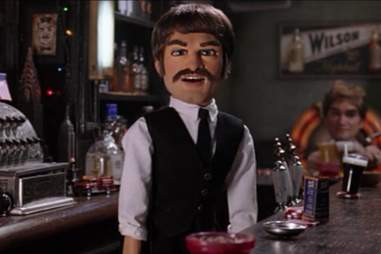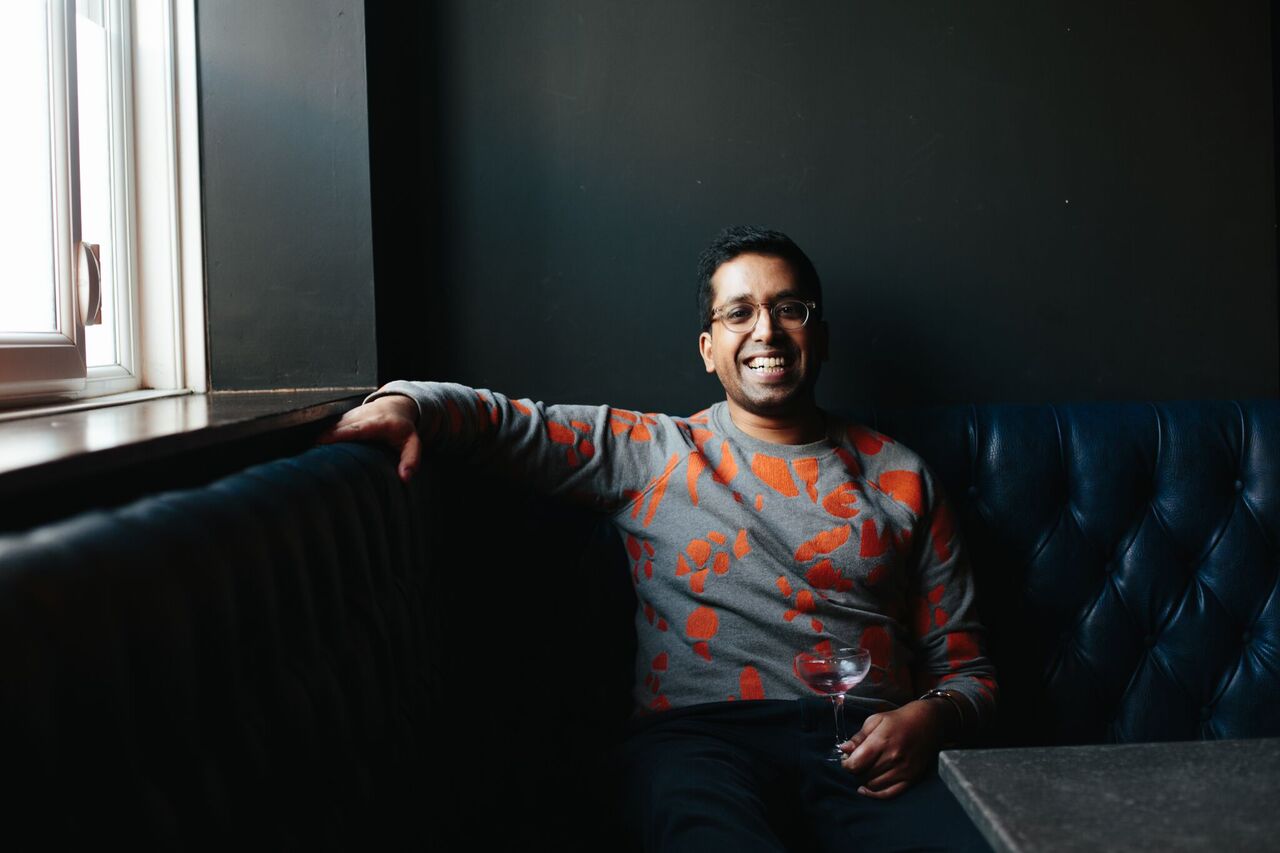Jeremiah 'Jerry' P. Thomas (October 30, 1830 – December 15, 1885) was an American bartender who owned and operated saloons in New York City. Because of his pioneering work in popularizing cocktails across the United States as well, he is considered 'the father of American mixology'. In addition to writing the seminal work on cocktails, Bar-Tender's Guide, Thomas displayed creativity.
Moe Szyslak: The Simpsons. Moammar “Moe” Szyslak, an unforgettable and often misconstrued. Jerry Thomas was not only the most famous bartender of his day, but his 1862 guide.
Thomas mixing his signature drink: The Blue Blazer | |
| Born | October 30, 1830 |
|---|---|
| Died | December 15, 1885 New York City, New York, USA |
| Occupation | bartender |
Jeremiah 'Jerry' P. Thomas (October 30, 1830 – December 15, 1885) was an Americanbartender who owned and operated saloons in New York City. Because of his pioneering work in popularizing cocktails across the United States as well, he is considered 'the father of American mixology'.[1] In addition to writing the seminal work on cocktails, Bar-Tender's Guide, Thomas displayed creativity and showmanship while preparing drinks and established the image of the bartender as a creative professional.[2] As such, he was often nicknamed 'Professor' Jerry Thomas.
Early life, education and work[edit]
Thomas was born about 1830 in Sackets Harbor, New York. (His 1885 obituary in the New York Times said 1832.)[2][3] As a young man, he learned bartending in New Haven, Connecticut before sailing for California during its mid-19th century Gold Rush.[4] While in California, Thomas worked as a bartender, gold prospector and minstrel show manager.[2] According to his 1885 obituary, he was left some money by his father, which helped in these travels.[3]
Saloon keeper and bartender[edit]
Thomas moved back to the East Coast in 1851, settling in New York City. He opened a saloon below Barnum's American Museum; it would be the first of four saloons he would run in New York City over his lifetime. After running this first bar, Thomas went on the road for several years, working as the head bartender at hotels and saloons in St. Louis, Missouri; Chicago, Illinois; San Francisco, California; Charleston, South Carolina; and New Orleans, Louisiana. At one point he toured Europe, carrying along a set of solid-silver bar tools.[4] He was well known for his showmanship as a bartender: he developed elaborate and flashy techniques of mixing cocktails, sometimes while juggling bottles, cups and mixers. He often wore flashy jewelry and had his bar tools and cups embellished with precious stones and metals. At the Occidental Hotel in San Francisco, Thomas was earning $100 a week—more than the Vice President of the United States.[2]
Bar-Tender's Guide[edit]
In 1862, Thomas finished Bar-Tender's Guide (alternately titled How to Mix Drinks or The Bon-Vivant's Companion), the first drink book ever published in the United States. The book collected and codified what was then an oral tradition of recipes from the early days of cocktails, including some of his own creations; the guide laid down the principles for formulating mixed drinks of all categories. He would update it several times in his lifetime to include new drinks that he discovered or created.[2][5] The first edition of the guide included the first written recipes of such cocktails as the Brandy Daisy, Fizz, Flip, Sour and variations of the earliest form of mixed drink, Punch. The 1876 edition included the first written recipe for the Tom Collins,[6][7] which appeared just after The Tom Collins Hoax of 1874.[6][7][8]
San Francisco & the Blue Blazer[edit]
Thomas developed his signature drink, the Blue Blazer, at the El Dorado gambling saloon in San Francisco.[9] The drink is made by lighting whiskey afire and passing it back and forth between two mixing glasses, creating an arc of flame.[2][10] Thomas continued to develop new drinks throughout his life.[3] His mixing of the 'Martinez', which recipe was published in the 1887 edition of his guide, has sometimes been viewed as a precursor to the modern martini.[2] Thomas claimed to have invented the Tom and Jerry and did much to popularize it in the United States; however, the history of the drink predated him.[3]
In New York City[edit]
Upon returning to New York City, he became head bartender at the Metropolitan hotel. In 1866 he opened his own bar again, on Broadway between 21st and 22nd Streets, which became his most famous establishment.[4] Thomas was one of the first to display the drawings of Thomas Nast. In his saloon he hung Nast's caricatures of the political and theatrical figures; one notable drawing, now lost, was of Thomas 'in nine tippling postures colossally.' The saloon included funhouse mirrors. This historic bar has been adapted for use as a Restoration Hardware store.[2]
Thomas was an active man about town, a flashy dresser who was fond of kid gloves and his gold Parisian watch. He enjoyed going to bare-knuckleprize fights, and was an art collector. He enjoyed traveling. By middle age he was married and had two daughters. Always a good sport, at 205 pounds he was one of the lighter members of the Fat Men's Association.[2] He had a side interest in gourds; at one point in the late 1870s, Thomas served as president of The Gourd Club after producing the largest specimen.[11]
Later years and death[edit]
Toward the end of his life, Thomas tried speculating on Wall Street, but bad judgments rendered him broke. He had to sell his successful saloon and auction off his considerable art collection; he tried opening a new bar but was unable to maintain the level of popularity as his more famous location.[3] He died in New York City of a stroke (apoplexy) in 1885 at the age of 55.[4] His death was marked by substantial obituaries across the United States.[2]The New York Times obituary noted that Thomas was 'at one time better known to club men and men about town than any other bartender in this city, and he was very popular among all classes.'[3] He is interred at Woodlawn Cemetery in the Bronx, New York City.
Bibliography[edit]
Thomas is known to have authored two books: How to Mix Drinks, or The Bon-Vivant's Companion (originally published in 1862, with new and updated editions in 1876, and again posthumously in 1887) and Portrait Gallery of Distinguished Bar-Keepers (originally published in 1867 and considered a lost book).
The titles of the books are organized by their outside cover titles / inside cover titles.
- How to Mix Drinks / How to Mix Drinks, or The Bon-Vivant's Companion (Dick & Fitzgerald Publishers, 1862)
- Portrait Gallery of Distinguished Bar-Keepers (1867)
- How to Mix Drinks (1876)
- Jerry Thomas' Bar-Tenders Guide / The Bar-Tender's Guide, or How to Mix All Kinds of Plain and Fancy Drinks - An Entirely New and Enlarged Edition (Fitzgerald Publishing Corporation, 1887)
Legacy and honors[edit]
- March 2003, a tribute was held for Jerry Thomas at the Oak Room at the Plaza Hotel in New York City, where bartenders gathered to make the many cocktails published in his books. The event was organized by David Wondrich, author of Esquire Drinks and a later biography of Thomas, and Slow Food, the organization devoted to traditional preparations of food.
- Thomas is featured in the Museum of the American Cocktail, founded in 2004[12] and housed with the Southern Food and Beverage Museum in New Orleans.[13]
- Cocktail writer David Wondrich has written a book about Jerry Thomas entitled Imbibe!: From Absinthe Cocktail to Whiskey Smash, a Salute in Stories and Drinks to 'Professor' Jerry Thomas, Pioneer of the American Bar. The book includes an extensively researched biography of Jerry Thomas, as well as the majority of Thomas' cocktails, taken directly from his books and adapted to modern-day measurement methods (ie: 1 ounce as opposed to 1 pony). The book was first published in 2007 and was the first cocktail book to win a James Beard Award. After years of additional research, Wondrich published a revised edition in 2015.[14][15]
- The Jerry Thomas Speakeasy opened in Rome, Italy, is named for the bartender.[16]
References[edit]
- ^Pete Wells, Frost on the Sun: Summertime Cocktails, New York Times, June 21, 2006.
- ^ abcdefghijWilliam Grimes, The Bartender Who Started It All, New York Times, October 31, 2007.
- ^ abcdefIN AND ABOUT THE CITY; 'A NOTED SALOON KEEPER DEAD.', New York Times, 16 December 1885. Note: The obituary says that he was born in 1832 and was later left money by his father.
- ^ abcdWilliam Grimes, CRITIC'S NOTEBOOK; 'Shaken, Stirred or Mixed, The Gilded Age Lives Again', New York Times, March 26, 2003.
- ^John Hodgman, All Shaken Up, New York Times, October 17, 2004.
- ^ abDifford, Simon (2008). Cocktails: Over 2250 Cocktails. diffordsguide. p. 351. ISBN0-9556276-0-5. Retrieved November 25, 2008.CS1 maint: discouraged parameter (link)
- ^ abSinclair, George (March 26, 2007). 'The Great Tom Collins Hoax'. Scribd. Archived from the original on December 2, 2008. Retrieved November 25, 2008.
- ^Walsh, William S. (1892). Handy-Book of Literary Curiosities. p. 450. Retrieved November 25, 2008.
Have you seen Tom Collins.
CS1 maint: discouraged parameter (link) - ^This notion is being challenged since no contemporary (to Jerry Thomas) historical evidence, or other, exists that proves or hints that Thomas was in San Francisco during the Gold Rush. Guillermo Toro-Lira. “El Dorado’s Jerry Thomas Mystery Explained”, December 30, 2010. Re-published and retrieved on April 18, 2020.
- ^Recipe: 'Blue Blazer', New York Times, October 31, 2007.
- ^The Gourd Club, New York Times, May 10, 1878.
- ^website
- ^[1]
- ^'Review: Imbibe!'. www.publishersweekly.com. Retrieved August 23, 2020.
- ^Sirens, Spirit (October 3, 2017). 'Imbibe: A Book Review'. Spirit Sirens. Retrieved August 23, 2020.
- ^https://www.thejerrythomasproject.it/en/
Further reading[edit]
- David Wondrich, Imbibe! (Perigee Books, 2007), a biography of Jerry Thomas and annotated recipe book of his drinks, by the drink correspondent for Esquire.
External links[edit]
Biggest Bartending School with three locations.
Get Placed in top bars in NJ.
Feel 100% safe with regular sanitization, social distancing and temperature checks.
Register NowWhy Our Bartending School ?
NEnglish and Spanish Classes
NThree convenient locations
NFlexibile Schedule
NCertificate valid in all states
NExperienced Instructors
NUnlimited Classes
N
Unlimited Practice
NMultiple Locations
NFREE Tool Bag
NFREE Trial Class
NHighest Placements in NJ
NPaid Internships
NFinance with $0 down
 N
NPayment Plans
NReserved FREE Parking
Register NowClass Schedule
Morning, Evening and Weekend Classes are offered at all three locations.New Classes start every Monday and Saturday
Morning Class Timing
10am – 2pm Monday – Friday for 1 weeksNext Class Starts
Every MondayEvening Class Timing
 6pm – 10pm Monday – Friday for 1 weeks
6pm – 10pm Monday – Friday for 1 weeksNext Class Starts
Every MondayWeekend Class
10am – 5pm for 2 weekendsNext Class Starts
Every SaturdayBecome a bartender in one week!Customize your schedule: Mix and match classes to fit your hectic lifestyle!
Follow Us on IG: famous_bartending_school
Snapchat: Famousbartender
LocationsAll three locations are one block away from train stations25 Prospect St. Newark, NJ 07105
53 Main Street Woodbridge, NJ 07095
Famous Bartending School
48 Mountain View Blvd Wayne, NJ 07470
Famous Black Bartenders
